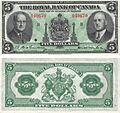Canadian chartered bank notes facts for kids
From 1871 to 1944, banks in Canada that had a special permission (called "chartered banks") were allowed to print their own money, known as bank notes. These notes were used by people all across Canada. After 1899, these banks also got permission to print notes for use in other British colonies, especially in the British West Indies. For many years, these banks were the main source of larger money notes in Canada and an important source of notes in the West Indies.
Things changed in 1934 when the Bank of Canada was created. This new bank was given the only right to print money for Canada. So, starting in 1935, the old bank notes from the chartered banks slowly stopped being used. By the end of 1944, Canadian banks were no longer allowed to print new notes for Canada. By 1950, the Bank of Canada became responsible for all the old bank notes still out there. You can still exchange these old notes at the Bank of Canada today. At that time, the total value of these old notes was over $13 million!
Contents
Money in Canada: Bank Notes from the Past
Canadian banks printed notes in many different amounts, like $1, $2, $3, $4, $5, $10, $20, $25, $40, $50, $100, $500, and even $1000. In 1871, the smallest note allowed was $4, which later changed to $5 in 1880.
Many different banks printed their own money in Canada over the years. Some well-known banks that issued notes included the Bank of Montreal, Bank of Nova Scotia, Canadian Bank of Commerce, and Royal Bank of Canada. The Royal Bank of Canada printed the very last bank note issued by a chartered bank in Canada in 1943.
Canadian Bank Notes in the British West Indies
Canadian bank notes were also used in the British West Indies from 1900 to 1950. They were used alongside notes from other banks, like the Colonial Bank (which later became Barclays Bank), and some smaller notes printed by local governments.
Several Canadian banks issued notes for these islands. The Canadian Bank of Commerce, Bank of Nova Scotia, and Royal Bank of Canada were some of the main ones. They printed notes for places like Barbados, Jamaica, Trinidad, Antigua, British Guiana, Dominica, Grenada, St Kitts, and St Lucia. The amounts varied, but often included $5, $20, and $100 notes, and sometimes £1 or £5 notes in places like Jamaica.
Images for kids
-
Colonial Bank of Canada, Toronto, 1859, $4. This note shows Lady Justice and a portrait of Queen Victoria.
See also
- Bank of Canada
- Canadian pound
- Canadian banknote issuers
- Currencies of the British West Indies







